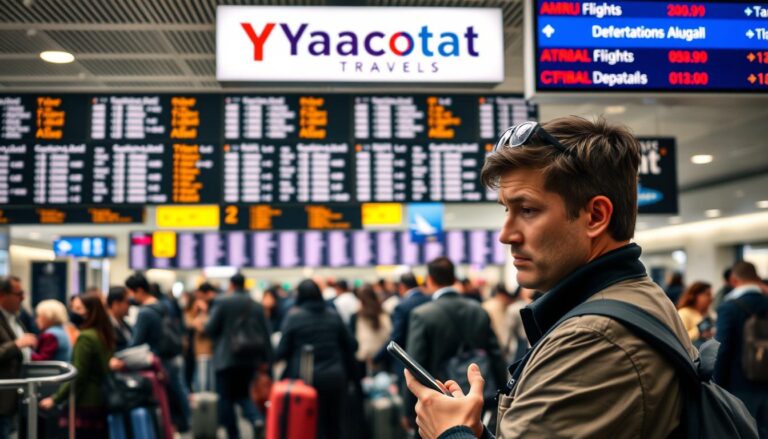Why You Should Always Book Flights at 2 AM
Did you know airlines can change their fares hundreds of thousands of times a single day? That’s a massive number. It shows how dynamic airfare really is. The old story about a magical 2 AM booking hour is mostly a fun myth.
But the core idea is spot on. Timing is everything when you want to save on air travel. This guide cuts through the noise. We’ll show you the real strategies that work.
You will learn about airline pricing tricks and the ideal windows for securing deals. We’ve looked at the data from experts and real-world patterns. Our goal is simple: help you keep more money in your pocket for your next adventure.
By the end, you’ll know the smartest ways to approach booking flights. You’ll understand how to spot the lowest prices for your travel plans, whether you’re flying across the country or across the world.
Introduction: Discovering the 2 AM Booking Phenomenon
You’ve probably heard the advice to set your alarm for 2 AM to catch incredible flight prices. This strategy stems from airline practices that no longer exist. Today’s pricing systems work completely differently.
What Makes 2 AM a Game-Changer?
The truth is, 2 AM isn’t the magical hour it used to be. Airlines now use sophisticated algorithms that adjust fares constantly. These systems respond to demand and competition in real-time.
There’s no universal price drop across all routes at any specific hour. The idea of a single cheapest day for booking is also outdated. Modern airfare depends more on your specific travel plans.
| 2 AM Booking Myth | Modern Reality |
|---|---|
| Manual overnight fare updates | Real-time dynamic pricing algorithms |
| Universal price drops at 2 AM | Sporadic deals based on route and demand |
| Tuesday as guaranteed cheapest day | No single day consistently offers lowest prices |
| Staying up late for special advantage | Using tools and flexibility for real savings |
Setting the Stage for Strategic Booking
Instead of focusing on specific hours, understanding broader patterns is key. Setting up price alerts helps you spot genuine deals. Monitoring fares during quieter browsing periods can reveal opportunities.
The real advantage comes from strategic timing and flexibility. Using the right tools captures discounted fares when they appear. This approach consistently delivers better results than chasing old myths.
Understanding Airline Pricing Dynamics
Behind every flight price you see is a complex algorithm working in real-time. These systems constantly adjust fares based on demand, seat availability, and competitor actions.
This means the cost for your trip can change multiple times daily. Your search history and location can even influence the prices you are shown.
How Dynamic Pricing Impacts Fare Fluctuations
Dynamic pricing is the reason you might see different costs for the same flights at different times. Airlines use this model to maximize revenue on every route.
When one carrier lowers its prices, others often follow quickly. This creates short-lived opportunities for sharp-eyed travelers.
Insights from Recent Studies and Data
Recent data offers conflicting advice on the ideal day for booking. A 2025 Expedia study found Sunday had the lowest average fares.
However, a 2024 Upgraded Points analysis pointed to Monday or Tuesday. Google’s research concluded the day of the week holds little real value for savings.
| Study Source (Year) | Recommended Booking Day | Key Finding on Savings |
|---|---|---|
| Expedia (2025) | Sunday | Up to 17% savings on international tickets |
| Upgraded Points (2024) | Monday or Tuesday | Friday and Saturday are most expensive |
| No specific day | Minimal value in focusing on a single day |
The inconsistency in this data reveals a crucial point. Your travel dates and advance booking window matter much more than the day you click “purchase.”
Understanding these pricing dynamics helps you focus on flexible strategies. Using price alerts is far more effective than chasing a mythical cheap day.
The Best Time to Book Flights
Major travel studies have identified specific windows when airlines offer their most competitive pricing. Understanding these patterns can lead to substantial savings on your next trip.
Research-Backed Strategies to Save on Airfare
The Expedia Air Hacks report reveals a clear sweet spot for domestic travel. You’ll find optimal pricing when you make your reservation 34 to 86 days before departure.
This one to three month window typically offers about 25% savings compared to last-minute purchases. Google’s research supports this finding, showing prices often hit their lowest point around 44 days out.
For trips within the United States, consistently good deals appear between 21 and 60 days in advance. More recent data suggests 45-60 days before travel delivers the strongest value.
International journeys require different planning. The ideal booking window expands to 2-8 months ahead of your departure date. The most attractive deals usually surface 3-5 months before travel.
These timeframes work because airlines adjust prices based on demand forecasting. Targeting the middle window helps you capture fares when carriers compete for passengers.
Domestic Flights vs. International Travel Strategies
The strategies that work for short domestic hops won’t necessarily apply to long-haul international adventures. Your approach needs to match your destination’s unique pricing patterns.
Optimizing Booking Windows for U.S. Domestic Trips
For domestic flights within the United States, the sweet spot falls between one and three months before your trip. This 34-86 day window gives airlines time to adjust prices while still offering competitive fares.
Domestic routes have more competition and frequent departures. Carriers can dynamically adjust pricing closer to departure dates. This flexibility works in your favor when planning shorter journeys.
Timing Tips for International Journeys
International travel requires different timing strategies. Surprisingly, booking international tickets with just 18-29 days notice can save you 17% compared to planning three months ahead for certain destinations.
However, this varies by region. Trips to Mexico or the Caribbean show optimal pricing around 59 days out. European destinations typically offer the best deals about four months in advance.
For Asian and Oceanic destinations, plan five to seven months ahead. Longer-haul flights have fewer options and benefit from early booking. Your strategy should adapt to each specific region you’re visiting.
Impact of Holidays and Peak Travel on Airfare
Your vacation budget faces its biggest test during popular holidays. Understanding how seasonal demand drives up costs is crucial for smart planning.
Major events like Thanksgiving and Christmas create intense competition for seats. This high demand allows airlines to charge significantly higher prices.
How Holiday Demand Influences Prices
For Thanksgiving travel, aim to secure your flights by mid-October. Halloween is the absolute final deadline before a major price jump.
The lowest prices often appear about 35 days before departure. Christmas and New Year’s trips have a similar pattern.
You should purchase those tickets by Halloween. The ideal booking window is typically 32 to 73 days before the holiday.
Peak summer is another expensive period. Mid-June to mid-August sees the highest prices of the year.
| Peak Travel Period | Recommended Booking Deadline | Potential Savings Strategy |
|---|---|---|
| Thanksgiving | By Halloween | Book ~35 days pre-departure |
| Christmas & New Year’s | By Halloween | Aim for 51-day advance window |
| Summer (Mid-Jun to Mid-Aug) | Early Spring | Shift travel to September |
| Spring Break | Early February (Domestic) | Book international trips in December |
You can find much better deals by choosing off-peak times. January and September are fantastic months for travel.
You’ll enjoy lower prices and less crowded destinations. This strategic shift can save you over $100 per ticket.
Planning around these busy holidays ensures you keep your hard-earned money. Your next vacation can be both memorable and affordable.
Utilizing Price Tracking Tools and Alerts
Let technology do the heavy lifting when hunting for flight deals. Manually checking fares is time-consuming and often misses short-lived opportunities. Modern tools provide a smarter approach to finding the lowest price.
These services monitor flights around the clock. They send you alerts the moment a good deal appears. This saves you effort and ensures you never miss a price drop.
Setting Up Google Flights and Other Alerts
Google Flights is a powerful, free resource for travelers. Its “Track prices” feature is incredibly simple to use. After searching your route, just click the button to activate email alerts.
The platform’s algorithms compare current fare data to historical trends. This helps predict if prices are likely to rise or fall. You get notified immediately when a significant change happens.
Other excellent platforms like Hopper and Skyscanner offer similar functionality. Their mobile apps send push notifications for convenience. This allows you to monitor several potential trips at once.
![]()
Leveraging Fare Tracking Apps for Real-Time Savings
For more comprehensive deal hunting, consider subscription services. Dollar Flight Club scours the web for exceptional discounts. It sends curated email and SMS notifications about mistake fares and discounts up to 90%.
Their Premium+ plan offers SMS alerts for time-sensitive opportunities. This includes exclusive discounts on economy and business class flights.
Combining free tools like Google Flights with a subscription service creates a powerful system. You cover both planned trips and unexpected, incredible deals. This strategy maximizes your savings throughout the year.
Booking Timing Across Seasonal Trends
The calendar year presents four distinct booking seasons. Each requires a different strategy for optimal savings. Understanding these patterns helps you time your purchases perfectly.
Flight prices follow predictable rhythms throughout the year. Your approach should adapt to each season‘s unique characteristics. This knowledge puts you in control of your travel budget.
Strategies for Winter, Spring, Summer, and Fall
Winter months demand early planning for holiday travel. Aim to secure December flights 36-72 days in advance. The ideal deadline falls before November 19th.
January becomes a bargain hunter’s dream. You can save about $125 compared to November prices. Airlines offer post-holiday sales to fill seats.
Spring booking requires attention to spring break timing. Early March is your last chance for deals before prices surge. This is also the window for international summer trips.
Summer travel needs advanced tracking. Start monitoring prices 3-4 months ahead. The actual purchase should happen 1-2 months before departure.
Data on Seasonal Price Variations
Fall offers exceptional value during September and October. These shoulder months feature lower prices and smaller crowds. Thanksgiving travel has a clear sweet spot around 52 days out.
| Season | Optimal Booking Window | Average Savings Strategy | Peak Price Months |
|---|---|---|---|
| Winter (Dec-Feb) | 36-72 days pre-trip | $125 savings in January | December |
| Spring (Mar-May) | 4-10 months for international | Book before spring break | March-April |
| Summer (Jun-Aug) | 1-2 months pre-trip | Europe: $513, Hawaii: $377 | June-July |
| Fall (Sep-Nov) | 26-59 days for Thanksgiving | Wednesday flights save $102 | November holidays |
Finding the sweet spot in different months requires seasonal awareness. January, February, September, and October consistently offer the lowest prices. June, July, and December command premium rates.
You can save an average of $102 by flying mid-week. Wednesday departures often beat Sunday flights significantly. This day-of-week strategy works in every season.
Data-Driven Tips and Expert Advice
Cutting through the noise of flight booking myths requires relying on solid data from trusted sources. Industry experts analyze millions of ticket purchases to provide actionable advice.
Analyzing Trends from Multiple Web Sources
Hayley Berg, Hopper’s lead economist, offers crucial advice for international travel. She states planning ahead is key for the cheapest airfare.
Booking too early or too late often leads to overpaying. Berg also debunks the Tuesday booking myth.
She explains that prices change constantly based on route and dates. There is no single magical day for all flights.
Lindsay Schwimer, a consumer travel expert, highlights a powerful data point. Traveling Monday through Wednesday is about 13% cheaper than weekend travel.
Flying on Wednesday alone can save an average of $56 per domestic ticket.
| Expert Insight | Key Finding | Potential Impact |
|---|---|---|
| International Booking Window | Avoid too far in advance or last-minute | Prevents significant overpaying |
| Day-of-Week Myth | No single day guarantees lowest price | Focus shifts to flexible strategies |
| Midweek Travel | Monday-Wednesday cheapest | ~13% savings vs. weekends |
| Tool Adoption | 62% use fare comparison tools (Skyscanner 2023) | Embraces data-driven deal finding |
The consensus from these studies is clear. Use tools, target optimal windows, and fly midweek for the best prices.
Airlines use dynamic systems, making flexibility your greatest asset.
Extra Strategies: Rebooking and Points Management
Beyond just finding the initial deal, savvy travelers use two powerful techniques to maximize their savings. These strategies work after you’ve made your initial purchase and when planning how to pay.
They involve smart rebooking policies and getting the most value from your loyalty points.
How to Rebook When Prices Drop
A major policy shift helps you lock in a good fare early. Most U.S. airlines have eliminated change fees on standard economy tickets.
This means you can book a flight as soon as you find an acceptable price. Then, continue tracking the fare with tools like Google Flights.
If the cost drops, you can cancel your original ticket and rebook at the lower rate. This captures savings without penalty.

Remember, basic economy tickets are not eligible for changes. Your savings will typically come as a travel voucher, not a cash refund.
Maximizing Airline Miles and Credit Card Rewards
Using miles wisely is another key to big savings. First, determine if you’re getting good value for your points.
Use this simple formula: Cost of flight in cash / cost in miles = cents per mile (CPM). Aim for at least 1 CPM.
Save your miles for expensive international flights instead of short domestic hops. Premium cabins often offer the best rewards value.
Prioritize programs with transferable points for maximum flexibility. This two-pronged approach combines smart booking with strategic points use.
| Redemption Type | Typical Value (Cents Per Mile) | Smart Use Case |
|---|---|---|
| Short Domestic Flight | 0.5 – 1.0 | Better to pay cash |
| International Economy | 1.0 – 1.5 | Good value for long trips |
| International Business Class | 2.0 – 5.0+ | Excellent use of miles |
The Role of Alternative Airports and Flexible Dates
Flexibility with both dates and airports creates powerful opportunities for budget-conscious travelers. Being open to different options can significantly reduce your travel expenses.
Sometimes the biggest savings come from adjusting your departure and arrival points. Major metropolitan areas often have multiple airport choices with varying price points.
Exploring Savings with Alternate Airports
Choosing less popular airports can lead to substantial savings. For example, flying into Baltimore/Washington International instead of Washington Reagan can save you over $100 per ticket.
Oakland Airport often offers better prices than San Francisco International for Bay Area destinations. These alternate airports have lower fees and less competition.
Early morning or late night flights typically cost less. Fewer travelers want these inconvenient times, creating opportunities for savings.
Embracing Flexibility for Cheaper Options
Shifting your travel dates by just one or two days can make a big difference. Tuesday and Wednesday departures often cost significantly less than weekend flights.
Consider accepting connecting itineraries instead of insisting on nonstop flights. This strategy can save money and might even let you explore an additional city during your layover.
Booking flights scheduled to depart before 3 PM reduces cancellation risks. Later flights are more likely to experience delays that cascade throughout the day.
Using a VPN to compare regional prices can reveal hidden deals. Airlines sometimes show different fares based on your location.
Pro Tips for Ultimate Savings
There’s a whole world of advanced booking strategies that most casual travelers never discover. These expert techniques can transform how you approach flight shopping.
Professional travelers use specialized services to uncover incredible opportunities. These tools go beyond basic price tracking.
Insider Advice from Travel Experts
Subscription services like Dollar Flight Club and Thrifty Traveler employ teams that scan for pricing errors 24/7. They find mistake fares that save 70-94% off normal prices.
When you spot an incredible deal, book immediately. Wait for ticket confirmation before making other plans. Airlines may not honor these errors.
Little-Known Tricks to Slash Airfare Costs
Frequent flyer points offer excellent value for last-minute travel. Check award availability when schedules open and before departure.
Premium cabin seats often have the best redemption rates. This saves significant money on luxury travel.
| Strategy | Potential Savings | Best Use Case |
|---|---|---|
| Mistake Fare Services | 70-94% off | Spontaneous travel opportunities |
| Award Ticket Redemptions | 50-80% value | Last-minute premium cabins |
| Refundable Fare Monitoring | Free price insurance | Uncertain travel plans |
| Airline Status Concentration | Thousands yearly | Frequent business travelers |
Combining these strategies creates a powerful approach. You’ll save more money throughout the year on all your travel needs.
Conclusion
Modern flight booking success comes from understanding data-driven patterns rather than old wives’ tales. You now know the 2 AM myth is debunked. Real savings come from smart strategies and flexible planning.
Research shows domestic flights hit their sweet spot around 38 days ahead. International trips are cheapest around 50 days out. European travel needs about 94 days advance booking for the best time to secure deals.
Midweek travel saves up to 13% compared to weekends. Use tools like Google Flights to track prices throughout the year. This approach consistently beats chasing mythical discount windows.
Apply these methods for smarter flights all year long. You’ll find better prices and maximize credit card points. Your savings will grow with each trip you plan.







